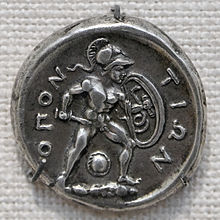Opuntian Locris

Opuntian Locris

Opuntian Locris or Eastern Locris was an ancient Greek region inhabited by the eastern division of the Locrians, the so-called tribe of the Locri Epicnemidii (Greek: Λοκροὶ Ἐπικνημίδιοι) or Locri Opuntii (Greek: Λοκροὶ Ὀπούντιοι).
Geography
Opuntian Locris consisted of a narrow slip upon the eastern coast of central Greece, from the pass of
Scarpheia and Thronium.[3] The only other river mentioned by name is the Platanius,[4] a small stream, which flows into the Opuntian gulf near the Boeotian frontier: it is the river which flows from the modern village of Proskyná.[5]
Opuntian Gulf
The Opuntian Gulf,Atalanta.
History
The Eastern Locrians, are mentioned by
Leonidas at the Battle of Thermopylae, and also sent seven ships to the Greek fleet.[9] The Locrians fought on the side of Sparta in the Peloponnesian War.[10] The Locri Opuntii also minted coins in antiquity, some of which survive. A number of authors refer to earthquakes which occurred in the area in 426 BC, causing significant damage.[11]
Cities and towns
The cities and towns of the Locri Epicnemidii, along the coast from north to south, were:
Naryx, and Corseia
.
See also
References
- ^ Strabo ix. pp. 416, 425.
- ^ Strabo ix. p. 425; Forchhammer, Hellenika, pp. 11-12; George Grote, History of Greece, vol. ii. p. 381.
- ^ Homer Iliad ii. 533; Strabo ix. p. 426; Ptolemy iii. 15. § 11; Pliny iv. 7. s. 12; William Martin Leake, Northern Greece, vol. ii. p. 67.
- ^ Πλατάνιος, Pausanias ix. 24. § 5.
- ^ Leake, vol. ii. p. 174.
- ^ ὁ Ὀπούντιος κόλπος, Strab. ix. pp. 416, 425, 426.
- The Iliadii. 527-535.
- ^ s. v. Ὀπόεις from Leake vol. ii. p. 181.
- ^ Herodotus vii. 203, viii. 1.
- ^ Thuc. ii. 9.
- Brill's New Pauly, s.v. Locri, Locris.
![]() This article incorporates text from a publication now in the public domain: Smith, William, ed. (1854–1857). "Locris". Dictionary of Greek and Roman Geography. London: John Murray.
This article incorporates text from a publication now in the public domain: Smith, William, ed. (1854–1857). "Locris". Dictionary of Greek and Roman Geography. London: John Murray.
- On the geography of the Locrian tribes, see William Martin Leake, Northern Greece, vol. ii. pp. 66, seq., 170, seq., 587, seq.
